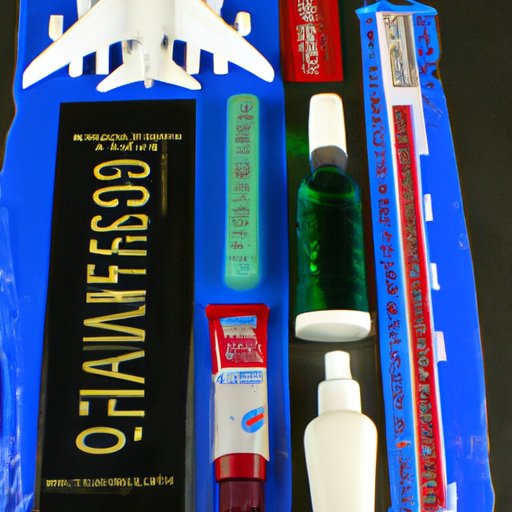Introduction
Toothpaste is an essential item in any traveler’s bag. Whether you’re going on a short weekend trip or a longer vacation, it’s important to make sure you have enough toothpaste to last the duration of your journey. But if you’re flying, you’ll need to know the rules and regulations set by the Transportation Security Administration (TSA) before you pack your toothpaste in your carry-on luggage.
Analyzing the TSA Regulations on Toothpaste in Carry-On Luggage
The TSA has strict guidelines when it comes to what you can and cannot bring on an airplane. It’s important to understand these regulations before you attempt to bring any items with you on your flight. When it comes to toothpaste, the TSA allows passengers to bring up to 3.4 ounces (100 milliliters) of liquids, gels, and aerosols in their carry-on luggage, as long as they are in containers that can fit inside a single quart-sized clear plastic bag.
What Are the Rules for Flying with Toothpaste?
When it comes to flying with toothpaste, the TSA has set some specific rules that you must follow. First, all toothpaste must be in containers that are 3.4 ounces (100 milliliters) or smaller. This means that any larger tubes of toothpaste must be packed in checked luggage. Additionally, all containers must be placed in a single quart-sized clear plastic bag. The bag must be able to close completely, and all items must fit inside without being squeezed or crushed.

Exploring the Different Types of Toothpaste Suitable for Air Travel
Given the restrictions on size and quantity, not all types of toothpaste are suitable for air travel. Generally, travelers should opt for smaller travel-size toothpaste tubes or single-use packets. These are typically available in most drugstores and grocery stores, and they are convenient for carrying with you on the plane. Additionally, there are some toothpastes that come in solid form, such as a bar or a tablet. These are also suitable for air travel, as they do not count towards the TSA’s liquid limit.

How to Pack Toothpaste for Air Travel
Once you’ve chosen the type of toothpaste you want to bring with you on your flight, it’s time to pack it properly. First, you’ll need to place all of your toothpaste containers into a single quart-sized clear plastic bag. Make sure that all of the containers fit inside without being crushed or squeezed. Once the bag is filled, seal it tightly and make sure all of the contents are secure. Finally, place the bag in an easily accessible part of your carry-on luggage so that you can quickly remove it when asked by a TSA agent.
How Much Toothpaste Can You Bring on a Plane?
The TSA states that passengers can only bring 3.4 ounces (100 milliliters) of liquid, gel, and aerosol items in their carry-on luggage. This includes toothpaste. However, there are some exceptions to this rule. Some airlines allow passengers to bring more than 3.4 ounces of toothpaste, as long as it is in a container that is less than one liter. Additionally, some airlines may allow passengers to bring larger containers of toothpaste if they are medically necessary.

Examining the Limits Set by the TSA
The TSA has set specific limits on how much toothpaste you can bring with you on a plane. All toothpaste must be in containers that are 3.4 ounces (100 milliliters) or smaller, and all containers must fit inside a single quart-sized clear plastic bag. If you are traveling with more than 3.4 ounces of toothpaste, you will need to check it in your luggage.
Exploring Exceptions to the Rules
Although the TSA has set limits on the amount of toothpaste you can bring on a plane, there are some exceptions. Some airlines may allow passengers to bring larger containers of toothpaste if they are medically necessary. Additionally, some airlines may allow passengers to bring more than 3.4 ounces of toothpaste as long as it is in a container that is less than one liter.
Conclusion
Traveling with toothpaste can be tricky, but following the TSA’s guidelines can help make the process easier. Passengers are limited to 3.4 ounces (100 milliliters) of liquid, gel, and aerosol items in their carry-on luggage, including toothpaste. However, some airlines may allow passengers to bring larger containers of toothpaste if they are medically necessary. When packing your toothpaste, make sure all containers fit inside a single quart-sized clear plastic bag and that the bag can close securely.
Summary of Main Points
When flying with toothpaste, passengers are limited to 3.4 ounces (100 milliliters) of liquid, gel, and aerosol items in their carry-on luggage. All containers must fit inside a single quart-sized clear plastic bag. Some airlines may allow passengers to bring more than 3.4 ounces of toothpaste as long as it is in a container that is less than one liter. Additionally, some airlines may allow passengers to bring larger containers of toothpaste if they are medically necessary.
Suggestions for Further Research
If you’re planning to fly with toothpaste, it’s important to research the specific regulations and guidelines set by your airline. Different airlines may have different rules and restrictions, so it’s important to know what to expect before you arrive at the airport. Additionally, it’s a good idea to contact the airline directly if you have any questions or concerns about flying with toothpaste.
(Note: Is this article not meeting your expectations? Do you have knowledge or insights to share? Unlock new opportunities and expand your reach by joining our authors team. Click Registration to join us and share your expertise with our readers.)
